Abstract:
The definitions of urban nonpoint source pollution were summarized, and the categories, sources, hazards and factors of urban nonpoint source pollution were discussed. In order to calculate the load of urban nonpoint source pollution, a series of urban non-point source pollution models, such as SWMM, STORM, MOUSE, etc., were developed. Because of the high concentration and more sources (such as streets, roofs, squares, rainfall, road-side trash, living sources, and pipeline deposition) of urban nonpoint source pollutants in China, difficulties may be encountered in the application of the foreign models to calculate urban nonpoint source pollution load. Based on the characteristics of urban nonpoint source pollution and the current applications of SWMM in China, the problems in the applications of urban non-point source pollution model were proposed, including model parameters valuing and validation, pollutant types selection for simulation and basic data obtaining, etc., and the recommendations of future study on urban nonpoint source pollution were provided.


